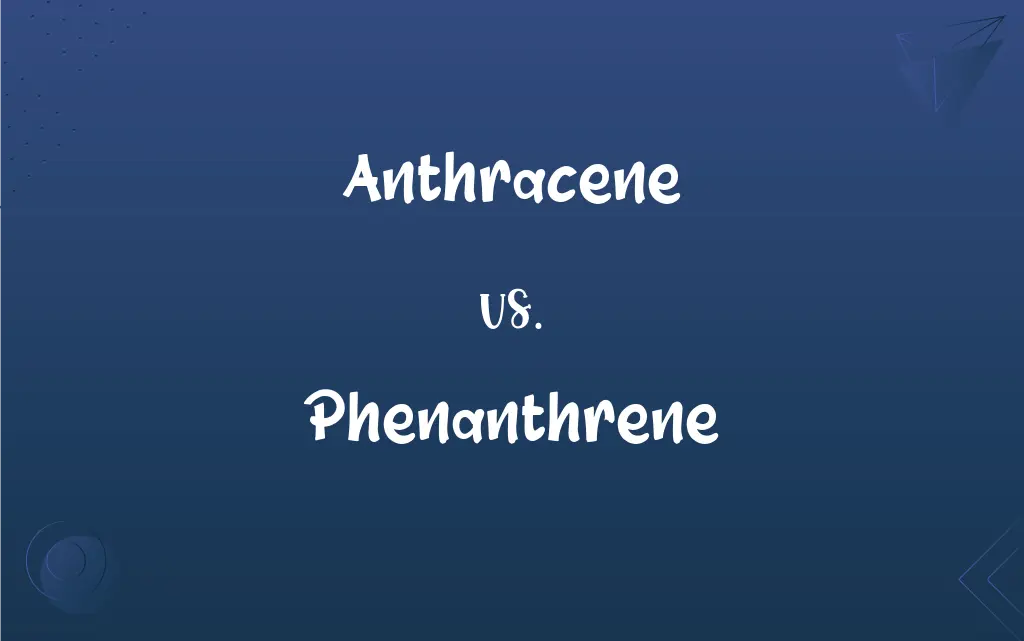Anthracene vs. Phenanthrene: What's the Difference?
Edited by Janet White || By Harlon Moss || Published on February 22, 2024
Anthracene is a solid polycyclic aromatic hydrocarbon (PAH) composed of three linearly-fused benzene rings, whereas phenanthrene has three benzene rings in a unique angular arrangement.

Key Differences
Anthracene is a crystalline hydrocarbon known for its three linearly arranged benzene rings. In contrast, phenanthrene, also a hydrocarbon, is characterized by its three benzene rings in a fused angular formation.
In anthracene, the molecular structure allows for electronic delocalization across the linearly connected rings. Phenanthrene's angular structure, on the other hand, creates a different electronic configuration.
Anthracene is utilized in the production of dyes, pigments, and the synthesis of other chemicals. Phenanthrene, while also used in chemical synthesis, has unique applications due to its distinct structure.
The reactivity of anthracene is influenced by its linear structure, making it a component in various chemical reactions. Phenanthrene's angular structure affects its reactivity and interaction with other compounds.
Both anthracene and phenanthrene are derived from coal tar, but their differing structures lead to varied uses in scientific and industrial applications.
ADVERTISEMENT
Comparison Chart
Molecular Structure
Three linearly-fused benzene rings
Three benzene rings in an angular fusion
Electronic Configuration
Delocalization across linear rings
Unique configuration due to angular rings
Chemical Reactivity
Influenced by linear structure
Altered by angular structure
Applications
Dyes, pigments, chemical synthesis
Specialized chemical uses
Source
Derived from coal tar
Also derived from coal tar
ADVERTISEMENT
Anthracene and Phenanthrene Definitions
Anthracene
Anthracene consists of three linearly-fused benzene rings.
The molecular structure of anthracene was key to the reaction.
Phenanthrene
Phenanthrene has three angularly fused benzene rings.
The unique structure of phenanthrene affects its chemical properties.
Anthracene
Anthracene has applications in organic synthesis.
In organic chemistry, anthracene is a precursor to various compounds.
Phenanthrene
Phenanthrene's structure influences its reactivity.
The angular arrangement of benzene rings in phenanthrene alters its reactivity in synthesis.
Anthracene
Anthracene is a solid polycyclic aromatic hydrocarbon.
Anthracene crystals were used in the laboratory experiment.
Phenanthrene
Phenanthrene is used in chemical research.
Researchers studied phenanthrene for its potential pharmaceutical applications.
Anthracene
Anthracene is derived from coal tar.
They extracted anthracene from coal tar for industrial use.
Phenanthrene
Phenanthrene is a type of polycyclic aromatic hydrocarbon.
Phenanthrene was detected in the environmental sample.
Anthracene
Anthracene is used in dye production.
Anthracene derivatives are important in synthesizing certain dyes.
Phenanthrene
Phenanthrene is found in coal tar.
During the coal tar distillation process, phenanthrene was isolated.
Anthracene
A crystalline aromatic hydrocarbon, C14H10, extracted from coal tar and used in the manufacture of dyes and organic chemicals.
Phenanthrene
A colorless aromatic crystalline hydrocarbon, C14H10, obtained by fractional distillation of coal-tar oils and used in dyes, drugs, and explosives.
Anthracene
(organic compound) A tricyclic aromatic hydrocarbon (an acene containing three fused rings) obtained from coal tar; used in the manufacture of wood preservatives, insecticides and the dye alizarin; it is isomeric with phenanthrene.
Phenanthrene
(organic compound) A tricyclic aromatic hydrocarbon obtained from coal tar; used in the manufacture of dyes, pharmaceuticals and explosives; it is isomeric with anthracene.
Anthracene
A solid hydrocarbon, C6H4.C2H2.C6H4, which accompanies naphthalene in the last stages of the distillation of coal tar. Its chief use is in the artificial production of alizarin.
Phenanthrene
A complex hydrocarbon, C14H10, found in coal tar, and obtained as a white crystalline substance with a bluish fluorescence.
FAQs
What distinguishes phenanthrene's structure?
It has an angular fusion of three benzene rings.
Where is anthracene commonly found?
It's typically derived from coal tar.
Can anthracene be synthesized in a lab?
Yes, it can be chemically synthesized.
How is anthracene structured?
It has a linear arrangement of three fused benzene rings.
What are the uses of phenanthrene?
It's used in specialized chemical synthesis and research.
Is phenanthrene reactive?
Yes, its angular structure influences its reactivity.
What is anthracene?
A polycyclic aromatic hydrocarbon with three linear benzene rings.
What is phenanthrene?
A polycyclic aromatic hydrocarbon with three angular benzene rings.
Is anthracene used in dye manufacturing?
Yes, it's a precursor in producing certain dyes.
How is anthracene extracted?
Typically, it's extracted from coal tar.
What makes phenanthrene unique chemically?
Its angular ring structure gives it unique properties.
Does phenanthrene occur naturally?
Yes, it's found in coal tar and other natural sources.
How does anthracene react with other chemicals?
Its reactivity is influenced by its linear structure.
What role does phenanthrene play in industry?
It has niche applications in chemical industries.
Is anthracene soluble in water?
It has very low solubility in water.
Is phenanthrene a common compound in chemistry?
It's well-known in chemical and environmental studies.
What research is being done on phenanthrene?
Studies focus on its chemical behavior and potential applications.
Are there environmental concerns with anthracene?
Yes, like other PAHs, it can be a pollutant.
Can phenanthrene be toxic?
In certain concentrations, it can be harmful.
How is anthracene used in organic synthesis?
It's a precursor in synthesizing various organic compounds.
About Author
Written by
Harlon MossHarlon is a seasoned quality moderator and accomplished content writer for Difference Wiki. An alumnus of the prestigious University of California, he earned his degree in Computer Science. Leveraging his academic background, Harlon brings a meticulous and informed perspective to his work, ensuring content accuracy and excellence.
Edited by
Janet WhiteJanet White has been an esteemed writer and blogger for Difference Wiki. Holding a Master's degree in Science and Medical Journalism from the prestigious Boston University, she has consistently demonstrated her expertise and passion for her field. When she's not immersed in her work, Janet relishes her time exercising, delving into a good book, and cherishing moments with friends and family.
































































